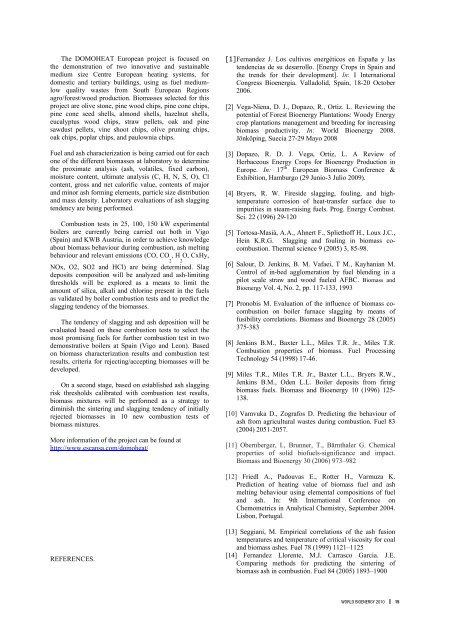Proceedings World Bioenergy 2010
Proceedings World Bioenergy 2010
Proceedings World Bioenergy 2010
Create successful ePaper yourself
Turn your PDF publications into a flip-book with our unique Google optimized e-Paper software.
The DOMOHEAT European project is focused on<br />
the demonstration of two innovative and sustainable<br />
medium size Centre European heating systems, for<br />
domestic and tertiary buildings, using as fuel mediumlow<br />
quality wastes from South European Regions<br />
agro/forest/wood production. Biomasses selected for this<br />
project are olive stone, pine wood chips, pine cone chips,<br />
pine cone seed shells, almond shells, hazelnut shells,<br />
eucalyptus wood chips, straw pellets, oak and pine<br />
sawdust pellets, vine shoot chips, olive pruning chips,<br />
oak chips, poplar chips, and paulownia chips.<br />
Fuel and ash characterization is being carried out for each<br />
one of the different biomasses at laboratory to determine<br />
the proximate analysis (ash, volatiles, fixed carbon),<br />
moisture content, ultimate analysis (C, H, N, S, O), Cl<br />
content, gross and net calorific value, contents of major<br />
and minor ash forming elements, particle size distribution<br />
and mass density. Laboratory evaluations of ash slagging<br />
tendency are being performed.<br />
Combustion tests in 25, 100, 150 kW experimental<br />
boilers are currently being carried out both in Vigo<br />
(Spain) and KWB Austria, in order to achieve knowledge<br />
about biomass behaviour during combustion, ash melting<br />
behaviour and relevant emissions (CO, CO , H O, CxHy,<br />
2 2<br />
NOx, O2, SO2 and HCl) are being determined. Slag<br />
deposits composition will be analyzed and ash-limiting<br />
thresholds will be explored as a means to limit the<br />
amount of silica, alkali and chlorine present in the fuels<br />
as validated by boiler combustion tests and to predict the<br />
slagging tendency of the biomasses.<br />
The tendency of slagging and ash deposition will be<br />
evaluated based on these combustion tests to select the<br />
most promising fuels for further combustion test in two<br />
demonstrative boilers at Spain (Vigo and Leon). Based<br />
on biomass characterization results and combustion test<br />
results, criteria for rejecting/accepting biomasses will be<br />
developed.<br />
On a second stage, based on established ash slagging<br />
risk thresholds calibrated with combustion test results,<br />
biomass mixtures will be performed as a strategy to<br />
diminish the sintering and slagging tendency of initially<br />
rejected biomasses in 10 new combustion tests of<br />
biomass mixtures.<br />
More information of the project can be found at<br />
http://www.escansa.com/domoheat/<br />
REFERENCES.<br />
[1] Fernandez J. Los cultivos energéticos en España y las<br />
tendencias de su desarrollo. [Energy Crops in Spain and<br />
the trends for their development]. In: I International<br />
Congress Bioenergia. Valladolid, Spain, 18-20 October<br />
2006.<br />
[2] Vega-Niena, D. J., Dopazo, R., Ortiz. L. Reviewing the<br />
potential of Forest <strong>Bioenergy</strong> Plantations: Woody Energy<br />
crop plantations management and breeding for increasing<br />
biomass productivity. In: <strong>World</strong> <strong>Bioenergy</strong> 2008.<br />
Jönköping, Suecia 27-29 Mayo 2008<br />
[3] Dopazo, R. D. J. Vega, Ortiz, L. A Review of<br />
Herbaceous Energy Crops for <strong>Bioenergy</strong> Production in<br />
Europe. In: 17 th European Biomass Conference &<br />
Exhibition, Hamburgo (29 Junio-3 Julio 2009).<br />
[4] Bryers, R. W. Fireside slagging, fouling, and hightemperature<br />
corrosion of heat-transfer surface due to<br />
impurities in steam-raising fuels. Prog. Energy Combust.<br />
Sci. 22 (1996) 29-120<br />
[5] Tortosa-Masiá, A.A., Ahnert F., Spliethoff H., Loux J.C.,<br />
Hein K.R.G. Slagging and fouling in biomass cocombustion.<br />
Thermal science 9 (2005) 3, 85-98.<br />
[6] Salour, D. Jenkins, B. M. Vafaei, T M., Kayhanian M.<br />
Control of in-bed agglomeration by fuel blending in a<br />
pilot scale straw and wood fueled AFBC. Biomass and<br />
<strong>Bioenergy</strong> Vol. 4, No. 2, pp. 117-133, 1993<br />
[7] Pronobis M. Evaluation of the influence of biomass cocombustion<br />
on boiler furnace slagging by means of<br />
fusibility correlations. Biomass and <strong>Bioenergy</strong> 28 (2005)<br />
375-383<br />
[8] Jenkins B.M., Baxter L.L., Miles T.R. Jr., Miles T.R.<br />
Combustion properties of biomass. Fuel Processing<br />
Technology 54 (1998) 17-46.<br />
[9] Miles T.R., Miles T.R. Jr., Baxter L.L., Bryers R.W.,<br />
Jenkins B.M., Oden L.L. Boiler deposits from firing<br />
biomass fuels. Biomass and <strong>Bioenergy</strong> 10 (1996) 125-<br />
138.<br />
[10] Vamvuka D., Zografos D. Predicting the behaviour of<br />
ash from agricultural wastes during combustion. Fuel 83<br />
(2004) 2051-2057.<br />
[11] Obernberger, I., Brunner, T., Bärnthaler G. Chemical<br />
properties of solid biofuels-significance and impact.<br />
Biomass and <strong>Bioenergy</strong> 30 (2006) 973–982<br />
[12] Friedl A., Padouvas E., Rotter H., Varmuza K.<br />
Prediction of heating value of biomass fuel and ash<br />
melting behaviour using elemental compositions of fuel<br />
and ash. In: 9th International Conference on<br />
Chemometrics in Analytical Chemistry, September 2004.<br />
Lisbon, Portugal.<br />
[13] Seggiani, M. Empirical correlations of the ash fusion<br />
temperatures and temperature of critical viscosity for coal<br />
and biomass ashes. Fuel 78 (1999) 1121–1125<br />
[14] Fernandez Llorente, M.J. Carrasco Garcia. J.E.<br />
Comparing methods for predicting the sintering of<br />
biomass ash in combustión. Fuel 84 (2005) 1893–1900<br />
world bioenergy <strong>2010</strong><br />
15









